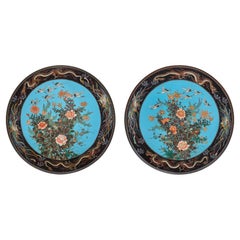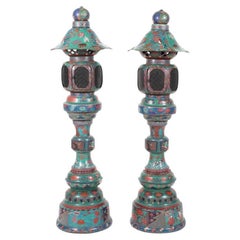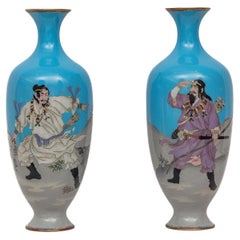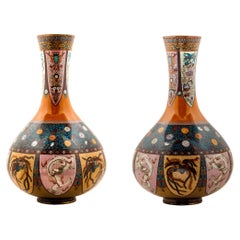Want more images or videos?
Request additional images or videos from the seller
1 of 14
Massive Pair of Chinese Cloisonne Enamel Figures of Attendants, Qing Dynasty
$60,000List Price
About the Item
- Dimensions:Height: 48.5 in (123.19 cm)Width: 21 in (53.34 cm)Depth: 21 in (53.34 cm)
- Style:Chinese Export (Of the Period)
- Materials and Techniques:
- Place of Origin:
- Period:
- Date of Manufacture:circa 1860
- Condition:Wear consistent with age and use. Minor fading.
- Seller Location:Queens, NY
- Reference Number:1stDibs: LU1798226101092
About the Seller
5.0
Vetted Professional Seller
Every seller passes strict standards for authenticity and reliability
Established in 1980
1stDibs seller since 2016
63 sales on 1stDibs
Typical response time: 2 hours
Authenticity Guarantee
In the unlikely event there’s an issue with an item’s authenticity, contact us within 1 year for a full refund. DetailsMoney-Back Guarantee
If your item is not as described, is damaged in transit, or does not arrive, contact us within 7 days for a full refund. Details24-Hour Cancellation
You have a 24-hour grace period in which to reconsider your purchase, with no questions asked.Vetted Professional Sellers
Our world-class sellers must adhere to strict standards for service and quality, maintaining the integrity of our listings.Price-Match Guarantee
If you find that a seller listed the same item for a lower price elsewhere, we’ll match it.Trusted Global Delivery
Our best-in-class carrier network provides specialized shipping options worldwide, including custom delivery.You May Also Like
A Marvelous Pair of Chinese Cloisonné Figures of Cranes on Stands, Qing Dynasty
Located in New York, NY
A Marvelous and Large Pair of Chinese Cloisonné Figures of Cranes on Stands. Step into the captivating world of Chinese artistry with this remarkabl...
Category
Early 20th Century Chinese Qing Animal Sculptures
Materials
Bronze
$15,500 / set
H 28 in W 22 in D 8 in
Pair of 19th Century Chinese Qing Dynasty Hardwood Figures of Immortals
Located in Dublin, IE
A Fine Pair of Chinese Hardwood Figures of Immortals
Qing Dynasty, 19th Century
A superb pair of Chinese scholar or Daoist immortal figures, each finely carved from dense, lustrous ...
Category
Antique 19th Century Chinese Qing Figurative Sculptures
Materials
Hardwood
$7,002
H 18.12 in W 7.09 in D 6.7 in
Large Chinese Cloisonne Enamel Bowl, Qing Dynasty
Located in Vero Beach, FL
Large Chinese Cloisonne enamel bowl, Qing Dynasty
Exceptional and finely decorated Chinese cloisonne punch bowl with gilt
metal foot and rim. The bowl has slightly flaring sides ...
Category
Early 20th Century Chinese Qing Metalwork
Materials
Copper, Enamel
Silver Figures of Eight Immortals Yangqinghe Jiuji Marks, Late Qing Dynasty
Located in New York, NY
Important and rare silver figures of eight immortals Yangqinghe Jiuji marks, Late Qing dynasty. Each hollow figure portraying one of the immortals in an animated pose, with highly detailed facial features, four pierced with apertures for the insertion of facial hair, clad in finely chased robes, all but two with their characteristic attributes, their bases bearing either two seal marks reading Yangqinghe Jiuji gongyibu and Zhe'ning Hu Qiusheng zao, or three marks in regular script reading Yangqinghe Jiuji gongyibu, Shang and Sheng zuo, original hand-carved wood stands. Measures: 11 1/4in (28.5cm) high (tallest one).
The earliest records of the silver atelier known as Yangqinghe date to 1775 in Shanghai...
Category
Antique 1890s Chinese Chinese Export Metalwork
Materials
Silver
$95,800 / set
H 11.25 in Dm 4 in
Pair of Chinese Cloisonné Tigers
Located in Houston, TX
A stunning pair of late 20th century life-size Chinese cloisonné tigers from the Baron Estate.
In Chinese symbolism, these tigers represents the ma...
Category
Late 20th Century Chinese Chinese Export Sculptures and Carvings
Materials
Brass
Chinese Qing Dynasty Wood Sculpture
Located in Dallas, TX
18th/19th Century Chinese Wood Sculpture Of A Emperor or General. Retains Some Polychrome Decoration And Horsehair Beard, Male Figure Seated On ...
Category
Antique Late 18th Century Chinese Qing Figurative Sculptures
Materials
Wood
Large Chinese Qing Dynasty Polychrome Enamel Bronze Cloisonne Charger
Located in Vero Beach, FL
Large Chinese Qing Dynasty polychrome enamel bronze cloisonne charger.
Unusual and rare bronze Chinese Qing Dynasty Cloisonne charger. The brightly ...
Category
Early 20th Century Chinese Qing Metalwork
Materials
Bronze, Enamel
Qing Dynasty Cloisonné Enamel Chinese Vase with Arabic Inscriptions
Located in London, GB
Qing dynasty cloisonné enamel Chinese vase with Arabic inscriptions.
Chinese, 19th century
Measures: height 11cm, diameter 17cm.
Crafted fo...
Category
Antique 19th Century Chinese Qing Vases
Materials
Enamel
Pair of Antique Chinese Cloisonne Birds
Located in Palm Beach, FL
Lofty pair of Chinese birds handcrafted in brass and decorated in cloisonne with floral and symbolic designs on an alluring blue background, featuring brass stylized tail feathers de...
Category
Early 20th Century Chinese Chinese Export Animal Sculptures
Materials
Metal
Pair of Antique Chinese Cloisonne Roosters
Located in Palm Beach, FL
Stand out pair of antique Chinese roosters handcrafted in enamel on copper or cloisonne in the traditional technique with bold colors of fauna and flora ...
Category
Early 20th Century Chinese Chinese Export Animal Sculptures
Materials
Copper, Enamel
More From This Seller
View AllMassive Museum Pair of Meiji Period Japanese Cloisonne Enamel Chargers Plates
Located in Queens, NY
A massive Museum pair of Meiji Period Japanese Cloisonne Enamel chargers plates, attributed to Hayashi Kodenji Studio, 19th century.
Each measuring ...
Category
Antique 19th Century Japanese Meiji Decorative Art
Materials
Enamel
Large Pair of Japanese Cloisonne Enamel Lanterns Attributed to Kaji Tsunekichi
Located in Queens, NY
A Large Pair of Japanese Cloisonne Enamel Lanterns Attributed to Kaji Tsunekichi, Edo Period, 19th century
Japanese cloisonne lanterns were made during the Meiji period, from the late 19th to early 20th century, and were often used as decorative lighting fixtures in temples and shrines.
Kaji Tsunekichi (1866-1916) was a Japanese cloisonné artist who was active in the late 19th and early 20th centuries. He was born in Tokyo and learned the art of cloisonné from his father, Kaji Sataro, who was also a cloisonné artist. He was renowned for his mastery of the shippo-yaki technique, which involves creating intricate designs with thin wires on a metal base before filling in the spaces with enamel.
Tsunekichi was known for his exceptional technical skills and his ability to create intricate designs with vibrant colors. His works often featured nature motifs, such as flowers, birds, and fish, which were rendered in a highly detailed and naturalistic style. He also experimented with new techniques, such as plique-à-jour, a type of cloisonné that creates a stained-glass effect.
Tsunekichi's works were highly prized during his lifetime and continue to be sought after by collectors today. He won numerous awards for his cloisonné creations, including a Gold Medal at the 1900 Exposition Universelle in Paris. His works are characterized by their fine wirework, precise enamel application, and attention to detail.
Some of Tsunekichi's most famous works include a pair of large cloisonné vases...
Category
Antique 19th Century Japanese Edo Metalwork
Materials
Copper, Enamel
Monumental Pair of Japanese Cloisonné Enamel Vases with Warriors, Ota Tamashiro
Located in Queens, NY
A Monumental Pair of Japanese Meiji Period Cloisonné Enamel Vases with Warriors, Dragon, and Falcon, Attributed to Ota Tamashiro
A monumental pair of Japanese cloisonné enamel vases...
Category
Antique 19th Century Japanese Meiji Vases
Materials
Copper, Enamel
Large Pair of Japanese Cloisonne Enamel Vases Attributed to Honda Yasaburo
Located in Queens, NY
A large pair of Japanese Cloisonne Enamel vases attributed to Honda Yasaburo, 19th century.
Finley decorated with the rich enamel colors of orange and green, these vases are desig...
Category
Antique 19th Century Japanese Meiji Metalwork
Materials
Copper, Enamel
Large Pair of Meiji Period Japanese Cloisonne Enamel Double Dragon Vases
Located in Queens, NY
A large pair of Meiji Period Japanese Cloisonne Enamel Double Dragon Vases, 19th century.
Japanese cloisonne enamel dragon vases are highly ...
Category
Antique 19th Century Japanese Meiji Metalwork
Materials
Copper, Enamel
An Exquisite Pair Of Japanese Cloisonné Enamel Vases with Chrysanthemum Blossoms
Located in Queens, NY
An Exquisite Pair Of Japanese Cloisonné Enamel Vases with Chrysanthemum Blossoms, Attributed to Hayashi, Meiji Period.
Experience the exquisite craftsmanship of the Meiji period wit...
Category
Antique 19th Century Japanese Meiji Metalwork
Materials
Enamel
Recently Viewed
View AllMore Ways To Browse
White Cloisonne
Empress Dowager
Antique Rings With Faces
Cloisonne Figures
Massive Pair Of Chinese
Mannequin Head
Palm Tree Sculpture
Pear Decorative Object
Wood Female Figure
African Dancer
Art Deco Chiparus
Bronze Cherub Sculpture
Bronze Satyr
Bronze Sphinx
Lladro Figurines
Marble Putti
Mercury Sculpture
Wood Putti



